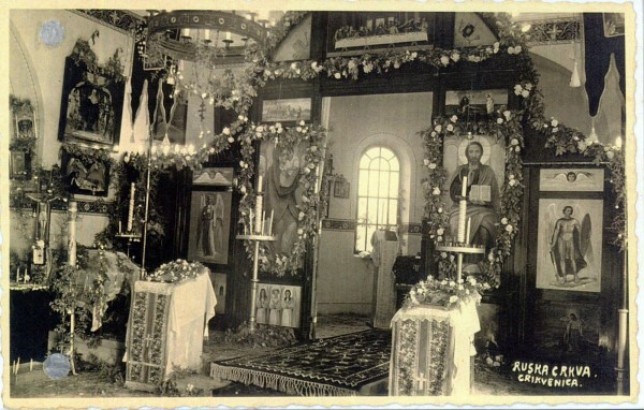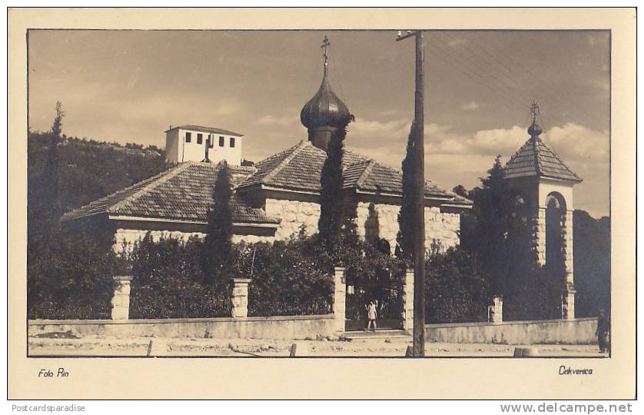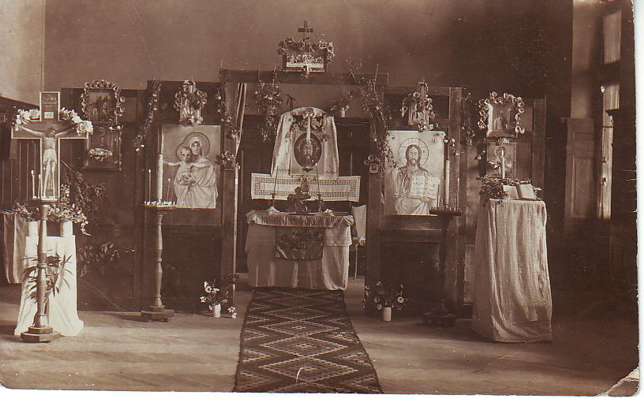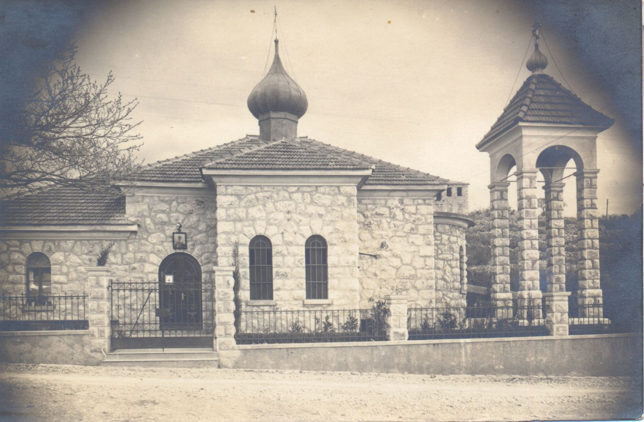
|
ABOUT PROJECT |
|
NEWS |
|
FROM ARCHIVES |
|
CONTACT |
|
|
FROM ARCHIVES
Russian Orthodox Church in Crikvenica

The Russian community in Crikvenica used to be one of the largest Russian congregations in the North Adriatic area in the beginning of the 20th century. The significance of the Russian community in Crikvenica is testified by the still preserved Orthodox shrine of St. Nicholas situated at the entrance to Crikvenica from the direction of Rijeka, above the Palace hotel, protected by the shadow of high trees. The story of the Crikvenica Russians begins in 1920. The first ship arriving to Bakar was called Vladimir, which came there on 12th December 1920 carrying a greater number of soldiers, civilians, women and children; almost 3000 people. From this transport, 200 people were sent to Crikvenica. A large number of Don Cossacks arrived to Crikvenica, and there were also Russians from Belarus and Russia. As some older residents of Crikvenica remember, there were even a few hundred Russians in their town. They lived in hotels and private homes in Crikvenica. The archival documents reveal that residents of Crikvenica and Selce feared the Russians would scare away their regular guests, for which reason the Health Department for Croatia, Slavonia and Međimurje in Zagreb sent an appeal to the Committee for Social Welfare requesting for "Russian refugees to be sent elsewhere", i.e. "to the country's inland".

The district authorities advised relocating the Russian refugees to the district of Virovitica and placing them in the Janković Castle in Suhopolje. That did not happen, because there was enough space for tourists in Crikvenica. According to the 1921 Population Census, Crikvenica was inhabited by 306 people whose mother tongue was Russian, of whom 173 men and 133 women. With time, the number of Russians declined, and thus in 1948 there were only 12 people declaring their ethnicity as Russian. Of a large number of Russians from the period after the First World War, there are only four families left in the town area until today. The Kosagov, the Smirnov, the Emilianov and the Usihanov family still preserve their national identity.
Bruno Kosagov remembers that his grandfather Ivan Kosagov arrived to Crikvenica from the town of Novonikolayevka on the Sea of Azov, nowadays Novoazovsk.
"Grandpa was born in 1899; he was a Don Cossack and lived in the military town of Novonikolayevka."
In Yugoslavia he might have first lived in the village of Grnja near Belgrade (because there is a photograph from that location with grandpa on it), and then he most probably came to Crikvenica where he met Kosagov's grandma Ljuba Lovrić, whom he married in 1927. They both worked, in their grandson's words, "at the Hungarian's", who at that time owned the Miramar and the Therapia hotels.
"Grandma worked at the Therapia, and gradpa at the Miramar. Gradpa's ID says that he was a bartender. He left his parents, his brother and sisters back in Novonikolayevka. However, he stayed in contact with them. They fled from Novonikolayevka to Mariupol, which was a bigger and safer city, and grandpa found out that his father and one sister had died in the time of the Holodomor."

A part of the family fled from the Soviet Russia to the USA, to Chicago. Grandpa died in 1939 and his life wish was to be buried in Russia, however his grave is at the Crikvenica cemetary. Crikvenica was also home to the Emilianovs, originating from nowaday Belarus. An elderly lady Meri Emilianova, a descendant of the Russian emigrants, still lives in Crikvenica. Her father worked at the Crikvenica harbour, while a member of the third family, Alexei Smirnov, was a well-known butcher who after the Second World War worked at the Gavrilović's in Petrinja. Russian painter V. Krasovski also lived in Crikvenica, whose paintings are still hanging in Crikvenica houses today, and photographer S. Afanasiev.
The Russians held events in the town, which were attended by the Russians from other places. Marija Vičić thus recalls the horse races that were organized by the Russians at the Crikvenica playground. According to Bruno Kosagov's story, the Don Cossacks would throw apples in the air there and then, riding horses, cut the apples in half with the sabres, while still flying.
Kosagov points out that the Orthodox church in Crikvenica is the only monument that the Russians left to the town. The Russian church in Crikvenica was built in 1924 and was, besides the Zemun and the Sarajevo Russian Orthodox Municipality, one of the three Russian Orthodox municipalities in the Kingdom of Yugoslavia. There is a document about the church being consacrated on 3rd February 1924. The construction of the church was initiated by Mrs Hartvig, a Russian lady and the wife of the then-ambassador of Russia to Belgrade and Mrs Milovanović, a Serbian lady and a widow, with the help of the contemporaneous Ministry of Religion of Pavle Gruić. It was designed by the engineer Stjepan Rovešnjak, and built by the local craftsmen: the Construction company of Stanko Car and the brothers Manestars' company from Sveta Jelena. According to Đurđica Ivančić-Dusper and her book Zmed gromač: Dih negdanje Crkvenice [Between the gromače: The spirit of old Crikvenica] published in 2004, the residents of Crikvenica loved going to the Crikvenica Russian church and listen to Russian church songs there.
Some women from Crikvenica would go and sing in the Orthodox church, despite not being Russian and Orthodox. The sound of the Orthodox church bells was characteristic of Crikvenica, where the three bells would all ring at once. The Orthodox church in Crikvenica was built exclusively for the Crikvenica Russians, and its appearance differs from Serbian Orthodox churches, which usually do not have a bell-tower separated from the nave.

In the Crikvenica Orthodox church the priest service was performed by Priest Dimitrije Kutjenko, and the assistant for church maintenance was General Sokolov, also a Russian emigrant. After the Second World War the Orthodox church in Crikvenica remained open, with ceremonies being held in it. One of the last ones was the wedding of Zrinka Cvitković, from Crikvenica, and Dimitrije Pricker, the son of a Russian refugee from Belgrade, which was held in 1957.
The ceremony was led by a Serbian Orthodox priest, because the Russian priest was no longer there. The last Russian priest Kutjenko emigrated from Crikvenica to the USA in 1943. In 1948 all Russian Orthodox shrines in Yugoslavia became property of the Serbian Orthodox Church, including the shrine in Crikvenica. In the mid-fifties of the 20th century Konstantin Janni Kapanni, the former keeper of the shrine in Crikvenica protested the Eparchy of Gornji Karlovac having jurisdiction over the church in Crikvenica, based on which he requested for the church to remain part of the Russian Orthodox Church. To succeed in his attempt, Kapanni established the Committee of Russians and Croats in Crikvenica. He particularly often had disputes with Paroch Simeon Ivošević, appointed by the Eparch of Gornji Karlovac. Today, the church is taken care of by an Orthodox priest from Rijeka. In the 1980s the church was renovated on the outside.
Nowadays, the association "Ruski dom" from Rijeka collects information on the history of Russians in the North Adriatic. While they were exploring the Russians in Crikvenica, they searched the birth, death and marriage registers of the Russian Orthodox Parochy of St. Nicholas in Crikvenica, which are found in the Crikvenica registry office. Kosagov points out that it is the key information on the Russian community in Crikvenica that can be found in these registers, because the numerous former Russians residing in Crikvenica are listed there. He adds that by using the still unrevealed data from archives in Croatia, Serbia and Russia it could be possible to put toghether the pieces of the former Russian community in Crikvenica.
Dr Filip Škiljan, Senior Research Associate
Institute for Migration and Ethnic Studies, Zagreb, Croatia
